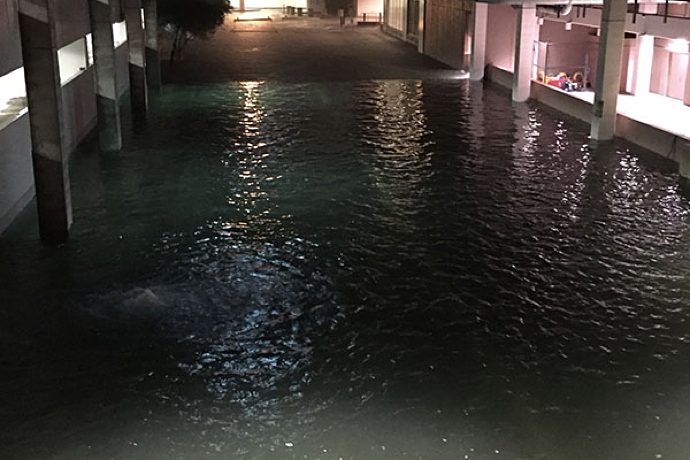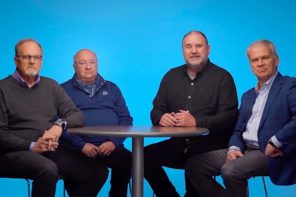On Saturday, August 26, Lakewood Church issued a statement on Facebook that they were going to be closed for Sunday services. Most churches in the Houston metropolitan area had announced the same via social media by then because conditions had deteriorated so rapidly on Saturday night.
In fact, on Sunday, August 27, Lakewood issued a statement that said it was “inaccessible due to severe flooding” and gave a list of shelters that would be open along with contact and location information. By Sunday evening the first round of tweets were swirling, asking why Lakewood wasn’t open as a shelter. And a subsequent video showing flowing and standing water in an underground garage of what was presumed to be Lakewood began circulating—as if to suggest that Lakewood was flooded and therefore not a place for shelter.
It seemed as though it was an open and shut case: the church was not open because it was flooded like many other places.
That all changed Monday, August 28 when pictures of Lakewood were shown without floodwaters anywhere to be seen. Even gossip sites such as Perez Hilton grabbed this story. This was all the fuel that critics needed. The court of public opinion tried and convicted Lakewood pastor Joel Osteen in a few short hours, and the public shaming continued into late Monday night.
Throughout Monday evening I watched my personal social media timelines begin to fill up with clergy and laypersons defending Osteen’s decision to not open Lakewood, arguing that un-coordinated efforts around facilities management could make the place inhospitable to evacuees. Many cited the failure of the Superdome in New Orleans during the aftermath of Katrina.
As someone who was a resident in New Orleans when Hurricane Katrina struck in 2005, I will never forget watching the news at my aunt’s house in south central Louisiana, after I had evacuated, as Coast Guard helicopters were rescuing people from their rooftops and dropping them off at the Superdome—the shelter of last resort. In short, the Superdome was not prepared to handle evacuees when it came to the basics of food, water and shelter. There was no food, not enough water, and the roof of the structure peeled off in the high winds. By week’s end, the toilets were no longer working and there were no staff equipped to handle medical emergencies. It had turned into a veritable hell.
What struck me most about the critics was their strong moral position against Osteen. Every thread of logic included his wealth and an individual perception of what it means to be a Christian or Christ-like—and any adjacent derivations thereof.
The basic reasoning was that because Osteen is rich and professes Christianity, the church should be opened. Seeing this ideological refrain proffered over and over again, I was certifiably interested in what perceptions informed this logic to the point that so many people were convinced they were not just right, but also the moral superior in the argument.
Far too often, American Christianity encourages its members to retreat into foxholes, digging ever deeper toward a vainglorious pursuit of moral superiority. The implied tone of those criticizing Osteen was that this really bad situation will be made right if rich-man Joel Osteen would just open his church.
At this point, Christians in America need to ask what is being projected if public perception assumes that magically, if an ultra-large megachurch opens as a shelter, then all will be made well. Magically. Henry Emerson Fosdick, former pastor of Riverside Church in New York famously preached that “God is not a cosmic bellboy for whom we can press a button to get things.” Yet, it appears as though much of American Christianity has, in essence, shaped God as one who answers to buttons that are pressed.
Osteen’s feel-good messages have long been an easy target for progressives who feel his soft, easy-going “Aw shucks” personality is not enough in the face of conversations around race, racism and LGBT inclusion. And Osteen is inclined theologically toward prosperity gospel—the idea that the sign of one’s faithfulness is best measured by material possessions and wealth.
In a recent era that has seen megachurch leaders’ finances under congressional investigation because of their lavish lifestyles and the various Occupy Wall Street protests, many see the likes of Osteen as no different than CEOs of corporations that received no retribution for their deleterious role in the Great Recession. This correlation highlights how certain veins of American Christianity function so closely with some of the core American ideals around free-market capitalism, wealth and consumerism. Prosperity gospel, for instance, only makes logical sense in a system of free-market capitalism. Those core American ideals have come under assault in very public ways when measured against the yardstick of liberation theology and faith-based social justice initiatives.
By Tuesday afternoon, August 29, news sources were reporting that Lakewood Church had been opened as a shelter. There were unverified pictures circulating on Twitter of blow-up mattresses being placed in the church for would-be evacuees. Donald Iloff, spokesperson for the church said “We have never closed our doors. We will continue to be a distribution center for those in need.” Iloff also said that Lakewood is prepared to be a shelter once other city and county shelters have filled up. CNN reported on Tuesday morning that at least three people arrived at the church seeking shelter, and were subsequently sent to a convention center downtown. However, by Tuesday afternoon, multiple network and cable news reports were showing evacuees arriving, as the downtown George R. Brown Convention Center was at capacity.
In a city with dozens and dozens of churches, some quite large, why was Osteen and Lakewood Church singled out in such a prominent way? It seems as though every negative assumption about organized religion and preachers—right or wrong—was projected onto Osteen. Likewise, every cynical opinion about megachurches and their members were flattened and placed on Lakewood. As easy as it is to give critics a dose of their own medicine and make reductionist claims about them, this should be an opportunity for American Christians to examine how their perception to a world that is growing increasingly secular has some dark corners that need to be exposed.
Rather than dismiss the claims as indicative of ignorance, it should be an opportunity to discuss the mechanisms in place that have allowed for such a perception to fester and grow. It’s worth noting that many people were not willing to give Osteen and the church the benefit of the doubt, but rather assume the worst intentions.
If American Christianity as an institutional notion expects to survive, let alone thrive in the next century, it must do a better job of holding its adherents accountable. Sometimes that looks like internal review, where clergy and laypersons speak out about wrongdoings amongst one another. Most recently we saw that when many individual churches and denominations held the Southern Baptist Convention (SBC) accountable for the initial failure to call and endorse a resolution that denounced white supremacy and white nationalism. Ultimately, SBC did the right thing.
But sometimes, in the case of Osteen and Lakewood Church, it looks like a larger public outside of the machinations of organized religion holding the church-folk accountable as well.
American Christianity would be wise to make sure it listens to both.





